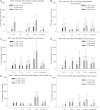Appetitive and consummatory ingestive behaviors stimulated by PVH and perifornical area NPY injections
- PMID: 19193934
- PMCID: PMC3509277
- DOI: 10.1152/ajpregu.90568.2008
Appetitive and consummatory ingestive behaviors stimulated by PVH and perifornical area NPY injections
Abstract
Food is acquired (obtained by foraging) and frequently stored (hoarded) across animal taxa, including humans, but the physiological mechanisms underlying these behaviors are virtually unknown. We found that peptides that stimulate food intake in rats stimulate food foraging and/or hoarding more than intake in Siberian hamsters. Neuropeptide Y (NPY) is a potent orexigenic peptide that increases food foraging and hoarding (appetitive behavior) and food intake (consummatory behavior). Given that NPY injections into the hypothalamic paraventricular nucleus (PVH) or perifornical area (PFA) increase food intake by rats, it is possible that these injections may stimulate food foraging or hoarding by Siberian hamsters. We also tested whether antagonism of the NPY Y1 receptor (Y1-R), the agonism of which stimulates hoarding, would inhibit post-food-deprivation increases in foraging and hoarding. We injected one of three doses of NPY or vehicle into the PVH or PFA of animals housed in a simulated foraging-hoarding housing system and measured these behaviors at 1, 2, 4, and 24 h. A subset of animals was subsequently food deprived and then given PVH or PFA Y1-R antagonist microinjections before they were refed. NPY PVH microinjections decreased foraging but increased hoarding and food intake, whereas NPY PFA microinjections increased all three behaviors, but the greatest increase was in hoarding. Y1-R antagonist inhibited post-food-deprivation increases in hoarding when injected into the PVH and PFA and inhibited foraging when injected into the PFA. These results support the view that NPY is involved in appetitive and consummatory ingestive behaviors, but each may be controlled by different brain areas and/or NPY receptor subtypes.
Figures








Similar articles
-
Arcuate nucleus destruction does not block food deprivation-induced increases in food foraging and hoarding.Brain Res. 2010 Apr 6;1323:94-108. doi: 10.1016/j.brainres.2010.01.078. Epub 2010 Feb 4. Brain Res. 2010. PMID: 20138163 Free PMC article.
-
Role of NPY and its receptor subtypes in foraging, food hoarding, and food intake by Siberian hamsters.Am J Physiol Regul Integr Comp Physiol. 2005 Jul;289(1):R29-36. doi: 10.1152/ajpregu.00853.2004. Epub 2005 Feb 10. Am J Physiol Regul Integr Comp Physiol. 2005. PMID: 15705801
-
PYY(3-36) into the arcuate nucleus inhibits food deprivation-induced increases in food hoarding and intake.Peptides. 2013 Sep;47:20-8. doi: 10.1016/j.peptides.2013.05.005. Epub 2013 Jun 29. Peptides. 2013. PMID: 23816798 Free PMC article.
-
Neuroendocrine regulation of appetitive ingestive behavior.Front Neurosci. 2013 Nov 15;7:213. doi: 10.3389/fnins.2013.00213. Front Neurosci. 2013. PMID: 24298235 Free PMC article. Review.
-
Mechanisms for AgRP neuron-mediated regulation of appetitive behaviors in rodents.Physiol Behav. 2018 Jun 1;190:34-42. doi: 10.1016/j.physbeh.2017.10.006. Epub 2017 Oct 12. Physiol Behav. 2018. PMID: 29031550 Free PMC article. Review.
Cited by
-
Energy deficiency promotes rhythmic foraging behavior by activating neurons in paraventricular hypothalamic nucleus.Front Nutr. 2023 Oct 12;10:1278906. doi: 10.3389/fnut.2023.1278906. eCollection 2023. Front Nutr. 2023. PMID: 37899828 Free PMC article.
-
Third ventricular coinjection of subthreshold doses of NPY and AgRP stimulate food hoarding and intake and neural activation.Am J Physiol Regul Integr Comp Physiol. 2012 Jan 1;302(1):R37-48. doi: 10.1152/ajpregu.00475.2011. Epub 2011 Oct 19. Am J Physiol Regul Integr Comp Physiol. 2012. PMID: 22012701 Free PMC article.
-
Central ghrelin increases food foraging/hoarding that is blocked by GHSR antagonism and attenuates hypothalamic paraventricular nucleus neuronal activation.Am J Physiol Regul Integr Comp Physiol. 2016 Feb 1;310(3):R275-85. doi: 10.1152/ajpregu.00216.2015. Epub 2015 Nov 11. Am J Physiol Regul Integr Comp Physiol. 2016. PMID: 26561646 Free PMC article.
-
The Roles of Neuropeptide Y (Npy) and Peptide YY (Pyy) in Teleost Food Intake: A Mini Review.Life (Basel). 2021 Jun 10;11(6):547. doi: 10.3390/life11060547. Life (Basel). 2021. PMID: 34200824 Free PMC article. Review.
-
Arcuate nucleus destruction does not block food deprivation-induced increases in food foraging and hoarding.Brain Res. 2010 Apr 6;1323:94-108. doi: 10.1016/j.brainres.2010.01.078. Epub 2010 Feb 4. Brain Res. 2010. PMID: 20138163 Free PMC article.
References
-
- Ammar AA, Sederholm F, Saito TR, Scheurink AJ, Johnson AE, Sodersten P. NPY-leptin: opposing effects on appetitive and consummatory ingestive behavior and sexual behavior. Am J Physiol Regul Integr Comp Physiol 278: R1627–R1633, 2000. - PubMed
-
- Bartness TJ, Clein MR. Effects of food deprivation and restriction and metabolic blockers on food hoarding in Siberian hamsters. Am J Physiol Regul Integr Comp Physiol 266: R1111–R1117, 1994. - PubMed
-
- Bartness TJ, Day DE. Food hoarding: a quintessential anticipatory appetitive behavior. Prog Psychobiol Physiol Psychol 18: 69–100, 2003.
-
- Beneke WM, Davis CH. Relationship of hunger, use of a shopping list and obesity to food purchases. Int J Obes 9: 391–399, 1985. - PubMed
-
- Benoit SC, Clegg DJ, Woods SC, Seeley RJ. The role of previous exposure in the appetitive and consummatory effects of orexigenic neuropeptides. Peptides 26: 751–757, 2005. - PubMed
Publication types
MeSH terms
Substances
Grants and funding
LinkOut - more resources
Full Text Sources
Research Materials
Miscellaneous

